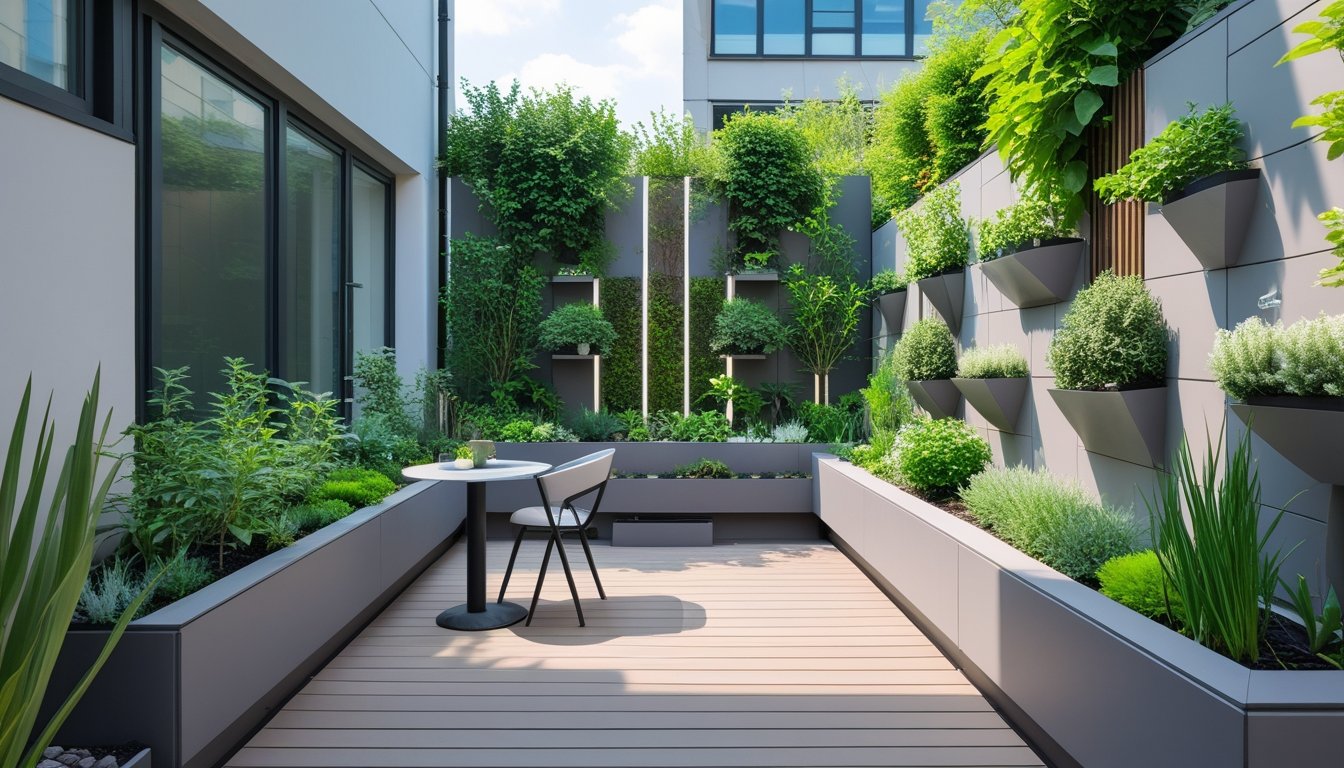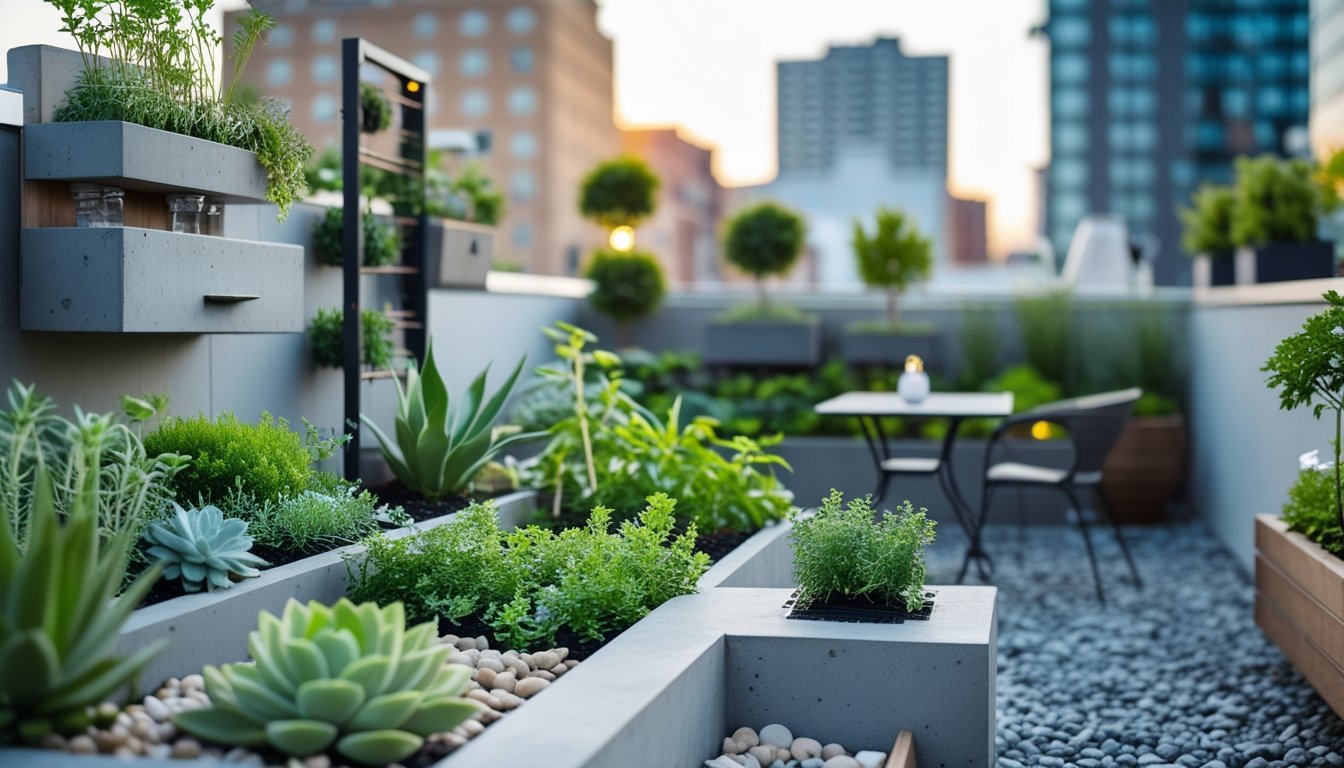Late updated: 07 Jul 2025 11:07
Written by: Daniel Harper
Modern Design Ideas for Small Urban Gardens: Transform Your Outdoor Space
In an era where urban living spaces are shrinking, the challenge of cultivating a garden in a limited area sparks creativity and innovation. We explore how contemporary designs can transform small urban gardens into lush, tranquil oases. Modern design ideas focus on maximising every inch of space through vertical planting, clever use of planters, and integrating nature with the latest trends in aesthetics.

Designing a small urban garden doesn't mean compromising on style or functionality. By utilizing clean lines, minimalist features, and borrowing views from the surroundings, we create an illusion of spaciousness while maintaining a personal touch. Whether it's a rooftop haven or a patio escape, modern designs offer a seamless blend of greenery and simplicity to any urban setting.
Join us as we navigate through various innovative solutions that redefine the concept of urban gardening. From stylish planter choices to incorporating privacy screens, each idea promises to enhance not just the beauty but also the usability of your space, making it a true extension of your home.
Key Takeaways
- Modern designs maximise space with vertical planting and minimalist features.
- Small urban gardens can be both stylish and functional using clever solutions.
- Innovative garden ideas make urban spaces an aesthetic extension of the home.
Fundamental Principles of Modern Urban Garden Design
Modern small urban garden design focuses on utilising available space effectively, choosing suitable plants, and seamlessly blending indoor and outdoor environments. These elements are crucial for transforming limited spaces into aesthetically pleasing and functional garden areas. Now, let's explore these principles in more detail.
Maximising Limited Space Through Creative Layouts
To maximise space in a small urban garden, strategic layout planning is essential. We should focus on vertical designs, such as trellises or living walls, to save ground space while adding greenery. Tiered planters and multi-level shelves offer additional planting levels and can enhance visual depth. Utilising pathways and seating cleverly creates zones for socialising and relaxation. Minimalist furniture that can be folded or stacked helps preserve open areas while providing functionality. This approach ensures every square metre serves a purpose, creating a balanced, organised urban garden.
Selecting the Best Plants for Small Urban Spaces
Choosing the right plants is key in designing a small urban garden. We opt for compact, low-maintenance plants that thrive in limited conditions. Evergreen shrubs and perennials provide year-round structure and greenery. Herbs or small fruit trees in containers offer utility and aesthetic value. Vertical climbers such as ivy or creeping fig can cover plain walls, adding lushness without consuming too much space. The aim is to select a diverse yet manageable assortment of plants that complement the modern garden's clean lines and cohesive look.
Integrating Indoor and Outdoor Garden Areas
Integrating indoor and outdoor spaces blurs the boundary between nature and home. We can employ large sliding doors or transparent walls to create seamless transitions. Indoor gardens with potted plants and hanging baskets that reflect the outdoor themes can unify design aesthetics. Continuing the same flooring or materials into both spaces also enhances cohesion. By creating visual continuity and functional flow between indoor and outdoor areas, small urban gardens become extensions of living spaces, offering a harmonious connection with nature.
Innovative Features and Solutions for Small Urban Gardens

Innovative gardening techniques allow us to make the most of limited urban spaces by integrating greenery into various environments. Exploring vertical gardening, balcony designs, and multi-functional structures can transform small areas into lush retreats.
Vertical Gardening Strategies for Urban Environments
In urban settings, where ground space is often scarce, vertical gardening is an essential strategy. Vertical planting not only makes efficient use of available space but also brings aesthetic appeal. We can create living walls by cultivating plants like succulents or rosemary on vertical structures. These walls not only beautify spaces but can help mitigate the urban heat island effect by cooling the surrounding environment.
To execute vertical gardens effectively, we might incorporate a trellis, or build a simple frame to support our plant selections. Hydrangeas add colour and variety, offering a vibrant sight throughout the changing seasons. Vertical gardening thus presents an ideal solution for those keen to maximise their urban greenery.
Designing Balcony and Terrace Gardens
Balcony and terrace gardens provide charming outdoor retreats in compact urban dwellings. Selecting lightweight planters and adaptable furnishings ensures easy movement and versatility. Our choice of plants, such as herbs like rosemary, or ornamental species like hydrangeas, adds both fragrance and charm.
Integration of clever watering solutions is crucial to maintaining plant health on balconies and terraces. Drip-irrigation systems represent a sustainable option, providing consistent moisture without excess. These small interventions enhance usability while adhering to structural considerations, ensuring our balconies remain welcoming and functional.
Using Multi-Functional Structures and Contemporary Materials
Multi-functional structures are key to optimising small urban gardens. Pergolas or retractable awnings serve dual purposes, offering shade while supporting climbers or hanging pots. Using contemporary materials such as steel and glass allows for sleek, modern aesthetics that blend seamlessly with urban environments.
We prioritise materials that are durable and weather-resistant to withstand city conditions. Innovative designs can incorporate seating, storage, or planters, making each square foot of garden space work harder. By combining these elements, we create dynamic gardens that adapt to various activities and preferences, encouraging us to enjoy our small urban sanctuaries to their fullest extent.
Frequently Asked Questions

When designing small urban gardens, creative space utilisation, cost-effective methods, and sustainable practices are essential. Incorporating modern design elements can enhance the aesthetic appeal while also addressing practical gardening needs, such as growing vegetables efficiently.
What are some creative ways to maximise space in a small urban garden?
Vertical gardening is a key strategy. Using trellises or wall-mounted planters helps to optimise limited space. Multi-functional furniture, such as benches with built-in planters, allows us to combine seating with greenery. Tiered plant stands also enable diverse plant arrangements without taking up much floor space.
How can one design a stylish yet cost-effective small garden in an urban setting?
Sourcing materials like pallets for DIY projects can be budget-friendly. Repurposing household items as planters saves money and adds uniqueness. Selecting hardy, low-maintenance plants reduces costs associated with frequent replacements. Simple upgrades, like painting existing pots or using affordable solar lighting, enhance style without breaking the bank.
What are the best practices for growing vegetables in small urban garden spaces?
We should focus on high-yield, compact crops like herbs, cherry tomatoes, or salads. Using raised beds or containers with quality soil ensures good drainage and nutrient availability. Implementing a rotation plan prevents soil depletion and supports healthy growth. Regularly monitoring for pests and maintaining irrigation improves productivity.
Could you suggest some design strategies for small gardens to create the illusion of more space?
Incorporating mirrors expands perceived space. Reflective surfaces double visual depth, making areas feel larger. Choosing light-coloured, minimalistic furniture reduces visual clutter. Diversifying plant heights and textures creates layers. Delineating zones with different materials or plant species offers structure and enhances the sense of spaciousness.
What are the essential elements to include in a small urban garden for a modern look?
Geometric shapes and clean lines are fundamental. We should consider integrating sleek planters and streamlined furniture. A restricted colour palette ensures cohesion. Statement pieces, like a central sculpture or a uniquely shaped pot, serve as focal points. Incorporating modern lighting fixtures enhances ambiance, transforming spaces during evenings.
How can urban dwellers incorporate sustainable practices into their small garden designs?
Using recycled materials for planters supports sustainability. Native plants reduce water requirements and enhance local ecology. Installing rainwater collection systems for irrigation conserves resources. We can use organic compost from kitchen scraps to enrich soil naturally. Incorporating these practices not only benefits the environment but also contributes to the overall health of the garden.
